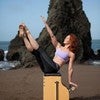Description
About This Video
Transcript
Read Full Transcript
I'm going to show some variations. It can be done with the ladder barrel. It's utilized so extensively. I love it. A lot of things are slightly less commonly done, very useful to starting out. If I have somebody who's very stiff in the hamstrings or legs just getting, they can even have their foot on the lowest drum. Just pushing back and stretching out is a wonderful way to help people. They don't have to go all the way.
Some people can barely get a hamstring stretch, but it starts to loosen up and open up the leg muscles. This is really basic basic for ballet stretches to be honest so someone's not up to the full ballet stretches because the hamstrings are too tight. This is a wonderful way to start to get them going. The same goes just pressing in and stretching out, pressing in and stretching out. Of course more slowly, so pressing in.
If you notice the hip is just and stretching, pressing in and you can always add the hand to that just to work into the hips a little bit and working quad and thigh stretch, bringing the foot up, hips go back and then bringing the hips forward. Very nice for all levels watching out that the hips stay very even and long. So one hip isn't hiked up per se. So there's a few ways this stretch can be interpreted actually, and it's a placement of the hips of the Hams. The quads are tight and the lower back is tight, the back will be more arched and the emphasis is attempting to get this low elongation of the sitz bones in the sacred [inaudible] so the lower back is long. Sometimes the body will not be perfect at the beginning, but it's good to do it anyway and wonderful way to stretch the spine.
The back wind is a fantastic place to get traction in the spine, so if the sacrum is locked, a lot of times people just bend back and they missing a huge opportunity with the help of their hands to elongate and lengthen out the lower spine so you're really tractioning the back and you're getting much deeper into the chest. Once the body is more open and they can get a good grip on the ladder barrel on the latter part of the barrel, you add the three circles with the legs, lower them down, hands to the waist, roll up through the spine and then feet and Pilati or together grab the side of the ladder barrel and very conscientiously roll down, keeping track. Even walking down with the hands till you get to the edge part that you can grab and pulling and stretching me with the arms. Some people cannot get their knees straight. That's fine. They may need to have their feet further out.
It's all starts to unravel the body and make it work. Then a variation for some people, if that's, they're not ready for that, they can have their feet here and they go back the knees up and at first to anchor the sacred room and then they can stretch out if it's the appropriate size for the size for them, lengthening out the spine and reaching very, very popular has the waist and rolling back up another way. If they can't actually get to the barrel because they're too stiff, they start, they get a good anchor and they go back as far as they can and maybe they just, they can get to here, but that gravity is now starting to stretch and open them and it usually helps breathing, releasing the lungs, releasing the chest, releasing the upper back. So it's very nice with attention to get the sh elbows and the shoulders as open as possible. Very often people start to get looser and looser. If they do this three times, five times, seven times, they go deeper and deeper.
One of the wonderful ones to open up the hips that actually Romanis to do with me years ago was have a little ballet dancers or people at very tight hips and wanted to get them loose with the sand on the outside of the ladder barrel. Imagine a wall here and get the feet open. So you're in a kind of a frog like Charlie chaplain's position, and bend the knees a little bit and make sure that your knees are inline with the feet and then slowly move down and you can slide your hands down. So you're sliding down this ladder barrel on the outside with focus on getting the knees as wide as possible, attempting to get the hips right in line with the knees and rolling back up again. Now this is a little severe, but if there was a wall here, and Ramana used to think somebody was up to it like me, she would push the ladder barrel closer and have you go down again. So every time you're on a deeper and deeper and deeper rack to get the hips opening up.
So I leave that here with your judgment as to whether this is advisable or not to do, but the ones among us who got to do it usually absolutely loved it because it really released the hips so nicely and frankly if you're doing it without a wall the way I'm doing it now, it's a fabulous, fabulous way to focus on getting the hips open, the adductors, open the thighs and knees to the side works the legs and the hips a lot and you can really figure out what's happening with the spine and that is absolutely a wonderful thing. Another way to work with people's stiff backed people, especially to start to get into extensions and prepare them for things like swan, just to be draped over and lengthening up and going back down. So very safe, very conservative. If for some reason even this is too much, the hands can be on the ladder barrel so the person can actually just practice using their back muscles and getting this guys beautiful lift in the chest and the shoulders without any sense of vulnerability or insecurity and they're totally in control the whole time, which is one of the reasons it works so nicely working into the side body, placing the feet on a diagonal. The leg that's closer to the latter barrel is and on the inside, although there's no major law that says you can't do it the other way you can extend out and start to work the sides of the waist. What's Nice here is that you can really get a support from the barrel on the way out and come back up. If this is too much, guess what?
You can use the ladder barrel to really get you feeling how to move sideways, which is so nice to do and repeating to the other side. Again, the lane closest to the latter barrel is in the front and my hips are in the middle, so I would be working the side waist muscles and if I'm really feeling nervous or insecure, I can use this hand to help me get further up and down. And of course there's the ballet stretches. So one leg is in front. Love this one because you have a few variations you can do. You can curl in, extend out and come back up and then the reverses big lift up.
Literally use the ladder barrel to get the lift or with the hands on the side you can press down to elongate the trunk and then lengthen a long spine out towards the legs. Pull the stomach in and then roll back up to lift. Then you add on to that. Once a spine is lifted, big lift of the sternum and arking back to upper back bend. You can work with the hands here to press down to have a beautiful lift, open the chest and a big back bend or small back button because we're really looking to open the chest forward and back to stretch. The hamstring a little bit further and then three lifts. If you can't lift the leg, just think about lifting it and you'll feel the muscles working.
I'll do the same to the other side, so curling in and stretching it out, reversing it long back, articulating in and one more time. Curling in and lengthening out, lifting and slight back. Bend lifting, opening the chest. One more time, lifting our king back and then sliding forward and back three times.
Ben's very interesting way to work this because you can have the priority either with the two hipbones even to the floor and perhaps the front dig a little bit further forward. Most people do not have a broad range of movement or you can choose the foot in line with the hip in line with the knee to the best that you can. Very, very different quality stretches. I seen them both used, they have different values and different priorities. More basic. I would totally work with the hips square as a problem solving tool. There's a place for the other one wants is a lot of experience in the person who's doing the exercise and a clear understanding of where they're going with it. So big lift through the rib cage and opening up the ribs and then making sure you bend from the hip socket to get the side.
When most people I've seen work here, so they're looking to keep the waist long and they're bending from the waist instead of from the hips and the hips are Pol and socket joint. They have a huge range of movement that the body can get into if you are taking advantage of that joint. So three times out in in and of course the same thing three times lifting. And then if it's a more advanced student, really opening up the thigh and working the inner leg around and aspiring to get the back leg in the middle of the Sh between the shoulder blades sliding back and forth, you can even lift the front leg up. Meaning, if you notice I'm rising up on the heel to get more lift and lifting the leg, working all the way up into the back. My teacher always used to say Ramana the leg should start from the top of the pelvis, the arm start from the base of the ribs. Interesting concept to play with when you are taking your movement into a larger scale. So you really are engaging and integrating your whole body.
So very quickly moving through the side stretches, sliding back and forth to massage the hamstring, massage, the adductor. And then big and important aspect is this lift up through the whole standing side body, that side, your pillar and your stabilizer. And the other one is where you get the lift from. And as you're working above the 90 degree angle, the body can no longer stay symmetrical. So it's a basically a physiological impossibility.
So one side of the rib cage will be long and one side will be short. And this is a safe place to have the alignment, nice lift of the chest. Of course I could come higher if I wanted to and lifting three times. And bringing the leg down. Wonderful place to do short box.
I'll go through the rolling back basically because it's such a lovely support of the spine. So on the way back, it's delicious massage to get that whole spinal column really imprinted into the barrel, stretching the arms down and then here's where there's a wonderful, wonderful place to work. The rolling motion of the spinal column and the powerhouse that is so different from working on the reformer one more time and actually great for beginners. Beginners feel very safe if they have their feet secure, they have a nice place to practice going back and there's much more support on a reformer. You're like falling off the side of a cliff and here you are really being held. So there's at times I will take beginner clients and actually go them into the more extended back Ben on the barrel and then give yourself a stretch.
So here you are. Most everybody can grab with the knees bent, you bend over, you use the arms to pull and then slowly work the legs straighter to get that extra traction. And of course there is a side to side ones. If you have a stick you can go with the twist.
Other side,
Really get that strapped. So you reverse the downward energy in your own body that may have been there. Then sideways stretch, reverse it, stretch, and she said, and now you're ready to grab your bag and walk out of the studio and you are gorgeous. And this is highly recommended to all teachers, me included. Please do enjoy.
Comments
Dolly - those pants are old ( maybe 6 years ? ) and were gifted to me by Siri Dharma, so not sure where she got them from.
You need to be a subscriber to post a comment.
Please Log In or Create an Account to start your free trial.




















